
(a)
The force
Answer to Problem 50QAP
The force
Explanation of Solution
Given:

Formula used:
Newton's first law; In equilibrium
Calculation:
Considering the equilibrium of forces in + x direction
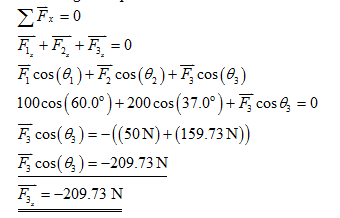
Considering the equilibrium of forces in + y direction (perpendicular to x direction)
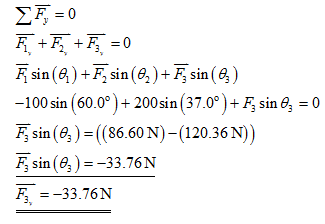
Conclusion:
Thus, component of force
(b)
Redraw the diagram with force
Answer to Problem 50QAP

Explanation of Solution
Given:
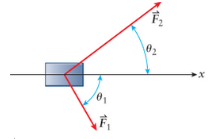
Formula used:
Newton's first law ; In equilibrium
Calculation:
Considering the equilibrium of forces in x direction,
Considering the equilibrium of forces in y direction (perpendicular to x direction),
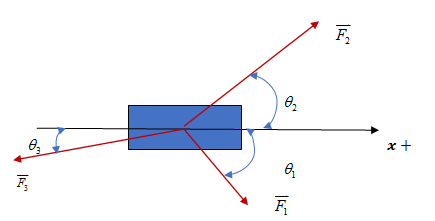
Conclusion:
Thus, the angle subtended by force
(c)
Direction of acceleration of the box
Answer to Problem 50QAP
The direction of acceleration relative to positive direction of x is
Explanation of Solution
Given:

Formula used:
Newton's second law ;
Calculation:
Considering forces in + x direction;
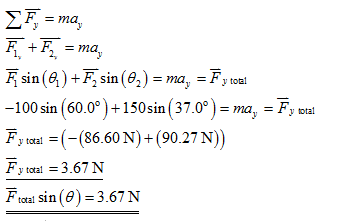
Considering the equilibrium of forces in + y direction (perpendicular to x direction);
Therefor the direction of the force
Acceleration is in the direction of the force. Therefor the direction of acceleration relative to positive direction of x is
Conclusion:
Thus, the direction of acceleration relative to positive direction of x is
(d)
Mass of the box
Answer to Problem 50QAP
Mass of the box is
Explanation of Solution
Given:
Acceleration of the box= 10 ms-2
Formula used:
Newton's second law ;
Calculation:

Conclusion:
Thus, mass of the box is
Want to see more full solutions like this?
Chapter 4 Solutions
COLLEGE PHYSICS
- The following force vectors act on an object: i) 25 Newtons at 45° north of east and ii) 50 Newtons at 30° south of east.. Which of the following represents the magnitude of the resultant and its angle relative to the easterly direction? O 61.4 Newtons 21.8 deg 55.6 Newtons -7.50 deg 61.4 Newtons -6.85 deg O 35.7 Newtons 0 deg O 75.0 Newtons 15 degarrow_forward4 250N GOON 30⁰ F3 450N F₁ 300 N * Determine the resultant force and it's direction, measured counterclockwise from the positive x axis.arrow_forward2-49. If the magnitude of the resultant force acting on the eyebolt is 600 N and its direction measured clockwise from the positive x axis is 0 = 30°, determine the magnitude of F, and the angle d. F 500 N F- 450 N Probs. 2-48/49arrow_forward
- The forces F1, F2, F3, ..... , Fn acting on an object are in equilibrium if the resultant force is the zero vector: F1 + F2 + F3 + g + ........+ Fn = 0. The given forces F1 = -2i + 3j, F2 = i - j, F3 = 5i - 12j are acting on an object. Then, a. Find the resultant force. b What additional force is required for the given forces to be in equilibrium?arrow_forwardQuestion Completion Status: Vector F1 = 625 N makes an angle of 2700 when rotated counterclockwise from the +x axis. Vector F2 = 875 N makes a 1200 angle from Vector F1 when rotated counterclockwise. What is the magnitude a vector needed to balance the two forces? O 580.6 N O-980.6 N O 980.6 N O 780.6 N O 78.2 N 680.6 N O-670.6 N O 86.2 Narrow_forwardDetermine the magnitude and direction of the resultant force R of the two forces shown below, where P = 4 kN and Q - 11 kN. P 50° 30° 30°arrow_forward
- Three rugby players are pulling horizontally on ropes attached to a box, which remains stationary. Player 1 exerts a force F equal to 200 N at an angle 0, equal to –60.0° with respect to the +x-direction, as shown in the figure. Player 2 exerts a force F2 equal to 300 N at an angle 02 equal to 37.0° with respect to the +x-direction. The view in the figure is from above. Ignore friction and note that gravity can be ignored in this problem. Determine the force F3 exerted by player 3. State your answer by giving the x- and y-components, F3, and Fay, respectively. F, F3x -339.59 N F3y N Player 3's rope breaks, and player 2 adjusts by pulling with a force of magnitude F; equal to 250 N at the same angle as before. Defining angles above the x-axis as positive and those below as negative, at what angle 0 is the acceleration of the box relative to the +x-direction? The magnitude of the acceleration is measured to be 10.0 m/s?. What is the mass m of the box? kg m = F TOOLS x10arrow_forwardd) Given the forces F1 = 6.12 N, F2 = 4.32 N, F3= 1.84 N and their angles a= 16°, ß = 22°, y = 36°, calculate the force resultant R and its angles aR, BR, YR with the x, y and z axis. The forces are diagonals on each side of a rectangular parallelepiped. AF₂ Fx α > yarrow_forwardThe helicopter view in above figure shows two people pulling on a stubborn mule. The person on the right pulls with a force F1of magnitude 120N and direction of θ 1=60.0 0 The person on the left pulls with a force F2of magnitude 80.0N and direction of θ 2=75.0 0 . Find (a) the single force that is equivalent to the two forces shown and (b) the force that a third person would have to exert on the mule to make the resultant force equal to zero. The forces are measured in units of newtons (symbolized N).arrow_forward
- Three coplanar forces pull from a certain mechanism. The forces have the following magnitude and direction: 80N, 0° horizontally to the right 110N, 60° from the 80N force 60N, 225° from the 80N force. Find graphically the magnitude and direction of the resultant.arrow_forwardF1 F2 30 30 2. If the magnitudes F1 and F2 are both equal to 4.0 newtons, what are the horizontal and vertical components of components of the two forces? Be careful with +/- signs. Fıx = Fay =. F2x =, Fzy =.arrow_forwardTwo forces act concurrently on an object. Their resultant force has the largest magnitudewhen the angle between the forces is1. 0°2. 30°3. 90°4. 180°arrow_forward
 University Physics Volume 1PhysicsISBN:9781938168277Author:William Moebs, Samuel J. Ling, Jeff SannyPublisher:OpenStax - Rice University
University Physics Volume 1PhysicsISBN:9781938168277Author:William Moebs, Samuel J. Ling, Jeff SannyPublisher:OpenStax - Rice University Glencoe Physics: Principles and Problems, Student...PhysicsISBN:9780078807213Author:Paul W. ZitzewitzPublisher:Glencoe/McGraw-Hill
Glencoe Physics: Principles and Problems, Student...PhysicsISBN:9780078807213Author:Paul W. ZitzewitzPublisher:Glencoe/McGraw-Hill

